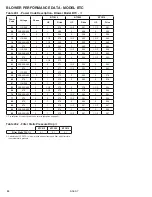
8
6-563.7
section B - vertical vent system Installation
B1. This section applies to vertically vented 2-pipe (1 combustion
air inlet pipe and 1 vent pipe) and concentric (single roof
penetration) vent systems and is in addition to “Section A -
General Instructions - All Units”.
B2. Vertical vent systems terminate vertically (up).
B3. It is required to install a tee with drip leg and clean out cap
as shown in Figure 8.1. Please note the following
requirements:
a. Only the vent system drip leg and condensate removal
drain connections are shown. Vent and combustion air
piping must be terminated per the instructions in this
manual, for either 2-pipe or vertical concentric vent
arrangements. All venting and drain components, except
condensate traps, are by others.
b. The standard vent drip leg and drain shown for U.S.
ONLY installations utilizes a tee, sized to match the vent
diameter for the model size (see Table 6.1). The tee
captures and directs the condensate to a cap that is
drilled and fitted with a 3/4" fitting for connection to the
condensate drain. For installation in Canada, see Note B3c.
c. The vent drip leg for Canadian installations must be
approved to ULC S636. This requires the use of a
series of reducers from the outlet of the tee to the drain
connection. Drilling or otherwise modifying the shape or
structure of any vent components is not allowed per ULC
S636. Note that the 3/4" condensate drain piping and
condensate traps are not subject to the ULC S636
requirements that apply to the vent system. This method
is also acceptable in US installations.
InsTAllATIon - venTIng
d. Connection of a combustion air inlet pipe is required to
be connected from the building exterior (not shown in
Figure 8.1).
e. Condensate drains are required for both the unit heater
and the vent system. Properly sized traps are included
with the unit. Proper drain design and installation is
critical to ensure that the unit and vent systems are
properly drained. Refer to the section titled “Condensate
Drain and Trap Installation” on page 13 for detailed
instructions.
B4. If a concentric vent system is to pass through one
common hole in the roof, please proceed at this point to
“Section D - Horizontal and Vertical Concentric Venting” for
instructions. Otherwise, proceed to note B5 for instructions
on terminating a 2-pipe installation.
B5. For 2-pipe vertical configurations, refer to the following
instructions and Figure 9.1 with minimum distances as
shown.
B6. The combustion air inlet and vent pipes must each be
terminated with two 90° elbows with screened openings
(four elbows total). The screens are available from Modine
as part of a kit. For model sizes 260 and smaller, the 4
elbows are to be PVC. For model size 310, the vent pipe
is to be terminated with 2 PVC elbows and the combustion
air inlet pipe is to be terminated with 2 galvanized or other
approved corrosion resistant metal elbows.
B7. The combustion air inlet and vent pipe terminations must
be positioned in opposite directions.
B8. Once venting is complete, proceed to the section titled
“Condensate Drain and Trap Installation” on page 13.
figure 8.1 - vertical venting system drip leg and Condensate drain Connections
To Building Exterior (refer to Note B3.a.)
Drain and trap to
sanitary sewer
connection for
condensate removal
➀
(refer to Note B3.e.)
Combustion Air Inlet
Pipe Connector
(refer to Note B3.d.)
Standard Vent
Drip Leg for
US ONLY
(refer to Note B3.b.)
Drip Leg for Canada
(Alternate for US)
(refer to Note B3.c.)
➀
Proper drain design and installation is critical to ensure that the unit and vent systems are properly drained.























